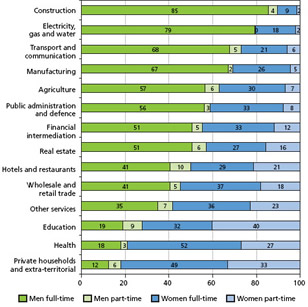
Horizontal
of women means that women generally work in different
of economy than men. Only 26% of Europeans work in
occupations, where the
is composed of both sexes in the
of at least 40%:60%. Half of all working women work in only two
- 34% in
and health and 17% in
and retail trade. In comparison, half of the jobs
by men are spread across three
: manufacturing (22%), wholesale and
(14%) and
(13%), thus confirming the horizontal
existing in the labour market. Even in the
with a large female workforce, women often find themselves in the
paid jobs. Out of those working in the education and health
up to 55% of men receive high
, as compared to only 27% of women.
This serves to further
the issue of vertical
in the labour market, or in other words, representation of women in
posts. Nevertheless, over the last 10 years there has been a slow, but steady,
in the proportion of female bosses in the European Union: from 20% in 1995, to 23% in 2000 to 25% in 2005. However, this rate is still much
than in the United States, where the equivalent
is 37%.
Although the
in the number of women in
posts is a positive development, it is not
. Most female bosses have female
. Whereas less than 10% of men have women as their
bosses, around 43% of working women in Europe have female bosses. Women also are more
to be managers of part-timers - 41% of part-timers have female bosses
to 21% of full-timers. Female managers are concentrated in
and workplaces with a
female/part-time workforce at the
end of hierarchies.